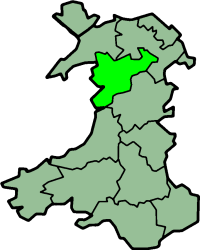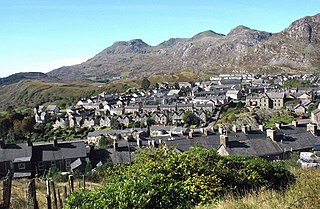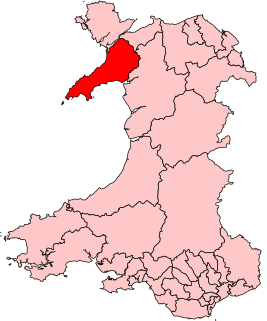| Merionethshire Constabulary | |
|---|---|
| Agency overview | |
| Formed | 1856 |
| Dissolved | 1 October 1950 |
| Jurisdictional structure | |
| Operations jurisdiction | Merionethshire, Wales, United Kingdom |
| General nature | |
Merionethshire Constabulary was the Home Office police force for the county of Merionethshire, Wales from 1856 until 1950.
The Constabulary was formed in 1856, under the County and Borough Police Act 1856, to replace the existing parish constables responsible for enforcing the law in local areas. The Constabulary was arranged into divisions or districts, including Aberdovey, Bala, Barmouth, Blaenau Ffestiniog, Corris, Corwen, Dinas Mawddwy, Dolgellau, Dyffryn, Harlech, Llwyngwril, Maentwrog, Pennal, Penrhyndeudraeth, Towyn and Trawsfynydd. [1]
Under the Police Act 1946, it amalgamated with Anglesey Constabulary and Caernarvonshire Constabulary to form the Gwynedd Constabulary in 1950, which was later renamed North Wales Police in 1974. [2] The Constabulary's archives are held at Gwynedd Archives. [3]

Gwynedd is a county and preserved county in the north-west of Wales. It shares borders with Powys, Conwy County Borough, Denbighshire, Anglesey over the Menai Strait, and Ceredigion over the River Dyfi. The scenic Llŷn Peninsula and most of Snowdonia National Park are in Gwynedd. Bangor is the home of Bangor University.

Since 1 April 1996, Wales has been divided into 22 single-tier principal areas, styled as counties or county boroughs for local government purposes. The elected councils of these areas are responsible for the provision of all local government services, including education, social work, environmental protection, and most highways. Below these there are also elected community councils to which responsibility for specific aspects of the application of local policy may be devolved. The last set of local elections in Wales took place in 2022, with the next due to take place in 2027.

Caernarfonshire, historically spelled as Caernarvonshire or Carnarvonshire in English, is one of the thirteen historic counties, a vice-county and a former administrative county of Wales.

Merionethshire or Merioneth is one of thirteen historic counties of Wales, a vice county and a former administrative county.

Meirionnydd is a coastal and mountainous region of Wales. It has been a kingdom, a cantref, a district and, as Merionethshire, a county.

Ffestiniog is a community in Gwynedd in Wales, containing several villages, in particular the settlements of Llan Ffestiniog and Blaenau Ffestiniog. It has a population of 4,875.

Cheshire Constabulary is the territorial police force responsible for policing the English unitary authorities of Cheshire East, Cheshire West and Chester, Borough of Halton and Borough of Warrington. The force is responsible for policing an area of 946 square miles (2,450 km2) with a population of approximately 1 million.

Caernarfon was a parliamentary constituency centred on the town of Caernarfon in Wales. It elected one Member of Parliament (MP) by the first past the post system.

North Wales Police is the territorial police force responsible for policing North Wales. Its headquarters are in Colwyn Bay. As of March 2020, the force has 1,510 police officers, 170 special constables, 182 police community support officers (PCSO), 71 police support volunteers (PSV), and 984 staff.

Nottinghamshire Police is the territorial police force responsible for policing the shire county of Nottinghamshire and the unitary authority of Nottingham in the East Midlands of England. The area has a population of just over 1 million.
The Police Act 1946 was an Act of Parliament of the Parliament of the United Kingdom that provided for the amalgamation of smaller borough police forces with county constabularies in England and Wales, allowed for the merger of county forces in certain circumstances and changed the boundaries of the Metropolitan Police District.
Denbighshire Constabulary was the Home Office police force for the county of Denbighshire, Wales from 1840 until 1967.
This article is about the particular significance of the year 1855 to Wales and its people.
This article is about the particular significance of the year 1812 to Wales and its people.
Flintshire Constabulary was the Home Office police force for the county of Flintshire, Wales, from 1856 until 1967.
Charles Edward Breese was a Welsh solicitor, antiquarian and Liberal politician.
Sir Hugh John Ellis-Nanney, 1st Baronet, was a Welsh landowner, magistrate and British politician.
Caernarvonshire Constabulary was the Home Office police force for the county of Caernarvonshire, Wales from 1856 until 1950.
Anglesey Constabulary was the Home Office police force for the county of Anglesey, Wales from 1856 until 1950.